Topic: Meeting Places (1066 etc.)
Map showing the position of Marsh House, Sudbourne, Suffolk.
The significance of Marsh House Sudbourne is that it was the meeting place of the Kemp and Munnings families. In the 1851 census Phineas Munnings, a marshman, was listed as head of the household. His daughter, Eliza was there. She had married James Kemp, a sailor, in Aldeburgh in 1848 and her two Kemp sons, William and James are listed in the Sudbourne census. Eliza went on to have five more children. Her last child, Edward was born in Aldeburgh in 1860.
Edward (Ted) Kemp was descended through a lineage of Suffolk Kemps that has been traced back to the Norman Conquest and the lands held by the Kempe family in and around the village of Peasenhall for almost a millennium. Ted Kemp was the first of this clan to breakaway from the land. By virtue of becoming a master mariner he migrated from Aldeburgh by way of Yarmouth north along the coast to Grimsby. There his daughter, Edna May, married Arthur Bellamy, the son of Fred Bellamy and elder brother of Ernest with whom this subject of ancestors and place began
.
This topic introduces thinking about a place-time syllabus to position oneself in a greater scheme of things. There are four categories of location where we can discover ourselves by expressing our reactions to belonging, place and change. These are locations where we can contemplate 'kinship', 'nature' 'conflict' and 'god'; as personal statements about cultural and ecology. As a subject, cultural ecology encourages the search for shared values in planet and cosmos to defuse confrontations where self interest, on one side or another, is seen as a supreme virtue. Shared meeting places are necessary for shared understanding.



Comments
Post a Comment